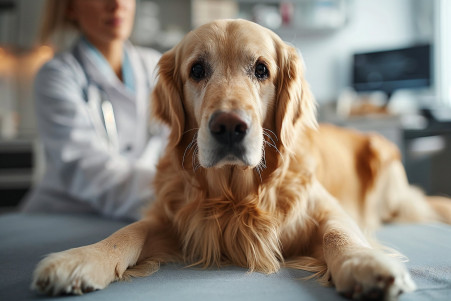Can Dogs Have Menopause? A Look at Canine Reproductive Aging
5 February 2024

Like humans, dogs experience changes in their reproductive systems as they age, but does this include menopause? No, dogs don’t go through menopause like humans. Female dogs can still have heat cycles and get pregnant at any age. When a dog is spayed, it ends her heat cycles, effectively creating a permanent menopausal state.
This article will use veterinary science and animal endocrinology to explore the physiological changes in the aging female dog. This will include an investigation of the impact of spaying, which is a form of induced menopause, as well as the medical issues and hormonal changes that occur as dogs get older. This will give a complete picture of the reproductive health and life span of our beloved dogs.
Can dogs have menopause?
The Estrous Cycle in Female Dogs
The estrous cycle in female dogs is not the same as the menstrual cycle in humans, which includes menopause. Instead, female dogs have an estrous cycle that includes proestrus, estrus, and anestrus and occurs about once or twice a year, according to PetMD. This cycle continues throughout a dog’s life without a natural end.
The frequency and regularity of a female dog’s heat cycles may change as she ages, but they don’t stop. It’s normal for older dogs to have less frequent or less regular heat cycles, but this is not the same as menopause. In fact, Rover.com notes that if a dog does stop having heat cycles, it could be a sign of a health problem rather than a menopause-like change.
Fertility also changes with age in dogs, and while older dogs can still get pregnant, the risks to both the mother and the puppies increase. Vet Help Direct notes that it’s important to understand the changes in fertility and the estrous cycle in female dogs because they can have a big impact on a dog’s health and well-being.
This information is important for dog owners to know so they can make informed decisions about their aging pets’ care, including whether or not to spay them or pursue other medical interventions.
How Spaying Impacts Canine Health
Spaying, which is the surgical removal of a female dog’s reproductive organs, immediately stops a dog’s ability to reproduce and her heat cycles.
While spaying is commonly done to prevent unwanted litters, it also has long-term health implications. However, the impact of spaying is not the same for every dog, so it’s important to consider a dog’s breed, size, and age.
The AKC Canine Health Foundation explains that spaying can reduce the risk of certain cancers and diseases. On the other hand, research published in PMC shows that spaying can increase the risk of joint disorders and certain cancers in certain breeds, including Golden Retrievers. This is thought to be due to the removal of gonadal hormones, which have important functions outside of reproduction, including influencing musculoskeletal and behavioral health.
The long-term health impacts of spaying depend on the age at which the surgery is performed. A study from the University of California, Davis found that spaying before the age of six months increases the risk of joint disorders and cancers in certain breeds more than others.
As a result, it’s important to make personalized decisions about spaying that consider a dog’s overall health history to ensure their long-term well-being. A personalized approach to spaying can help ensure that the risks and benefits are balanced for the health of older female dogs.
Hormonal Therapy for Incontinence in Senior Female Dogs
In addition to age-related changes, senior female dogs, especially those that have been spayed, may experience estrogen-responsive urinary incontinence.
Hormonal therapy can be used to treat this and other age-related conditions. For example, Incurin (estriol) and diethylstilbestrol (DES) are two hormonal therapies that are used to treat incontinence in senior female dogs.
Incurin, which is a once-daily tablet, is prescribed by veterinarians to reduce or eliminate urinary incontinence in spayed female dogs and has been shown in clinical studies to have a high success rate, according to Merck Animal Health. Meanwhile, Wedgewood Pharmacy explains that DES, a synthetic estrogen, is used to treat incontinence by mimicking the effects of natural estrogen.
While these therapies can be effective, they also have potential side effects. Incurin can cause side effects such as loss of appetite, vomiting, and a swollen vulva. Meanwhile, DES can cause side effects such as bone marrow suppression, which can be life-threatening, according to Wag. These therapies are typically considered after lifestyle changes and other treatments have been tried and failed, and the dog’s quality of life is being negatively impacted.
Veterinarian supervision is essential when considering hormonal therapies for incontinence in senior female dogs. Veterinarians need to adjust and monitor dosages to ensure the therapy is working and to catch and address any side effects. Hormonal therapy can help veterinarians improve the quality of life of senior dogs by treating specific age-related conditions, but it should always be used in the context of the dog’s overall health.
Alternatives to Sterilization: Hormone-Sparing Procedures and Hormone Restoration
Hormone-sparing sterilization procedures are an alternative to traditional spaying, which can have long-term effects on a dog’s health. Hormone-sparing procedures like vasectomy or ovary-sparing hysterectomy leave dogs with their natural hormones, which can have positive effects on their health and behavior.
Research from the Parsemus Foundation has shown that intact dogs and those that have undergone hormone-sparing sterilization have a lower risk of a variety of health issues than dogs that have been fully spayed or neutered.
The idea of hormone restoration therapy is also becoming more popular. While it’s not yet a common practice, hormone restoration therapy is seen as a natural next step in the treatment of health or behavioral issues that result from the loss of natural hormones after gonadectomy. The Parsemus Foundation notes that veterinarians have used hormone therapies, including estrogens and GnRH agonists, to successfully treat incontinence in spayed female dogs.
Pet owners should work with their veterinarians to consider the potential benefits and drawbacks of different sterilization options, taking into account their dog’s age, breed, and behavioral issues. They should also make sure to consider the evidence, including studies of hormone-sparing sterilization and hormone restoration, to make sure they’re making the best choice to improve their aging dogs’ quality of life.
The Physiology of Aging in Female Dogs
In addition to the changes that occur during menopause, female dogs also experience a number of other physiological changes as they age. Studies have shown that aging in dogs is associated with changes in the hypothalamic-pituitary-adrenocortical (HPA) axis, which leads to increased levels of stress hormones and a greater stress response.
An article in PubMed by Dr. J M Reul notes that older dogs have higher baseline levels of stress hormones like ACTH and cortisol, which may have implications for their health and behavior.
The immune system also changes as dogs age. A study in The Journals of Gerontology that followed dogs over time found that older dogs had increased markers of inflammation and oxidative stress, a process that parallels the human phenomenon of inflammaging. This immunosenescence can lead to a reduced response to vaccinations and a greater risk of infections.
Just like people, dogs can experience cognitive decline as they age. The American Kennel Club notes that conditions like Cognitive Dysfunction Syndrome (CDS), which is similar to Alzheimer’s disease, can lead to changes in memory, learning, perception, and awareness in older dogs.
Veterinarians and specialized nutrition are important for helping aging female dogs stay healthy. By recognizing these physiological changes and taking steps to address them, we can help ensure that our dogs live longer, healthier lives. This holistic approach to caring for senior dogs means that they can live out their later years in as much comfort and happiness as possible, even though they don’t go through menopause.
Conclusion: The Menopause Question and Canine Reproductive Aging
As we’ve delved into the details of canine reproductive aging, we’ve learned that dogs are different from humans in that they don’t experience menopause. Instead, dogs continue to have estrous cycles throughout their lives, although the regularity and fertility of these cycles may be impacted by age, but not the ability to reproduce.
When a dog is spayed, however, the veterinarian is essentially inducing a state of menopause by stopping the dog’s heat cycles and ability to reproduce. This has a number of health implications that go beyond the dog’s reproductive system.
We’ve explored how spaying can reduce the risk of certain cancers and how the veterinary community has developed hormonal therapies to treat the conditions that can arise in spayed dogs as they age. We’ve also looked at the development of hormone-sparing sterilization techniques that can provide a way to sterilize a dog while still allowing her to maintain her natural hormonal balance.
In the end, the health of aging female dogs is a complex issue that requires a combination of attention, understanding, and veterinary care. The fact that dogs don’t experience natural menopause means that it’s important for dog owners to seek out personalized veterinary care. By learning about canine reproductive aging and making informed decisions about their care, we can help our dogs live their best lives as they age.


